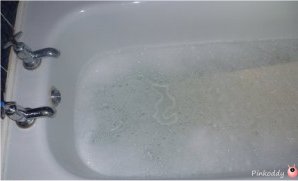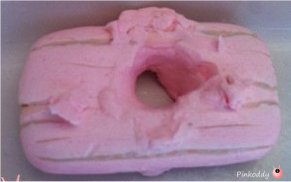Sensory Processing Disorder can be a problem when it affects day-to-day life, such as personal hygiene. Bathtime and keeping clean can be a problem but it is identifying exactly why, for each individual, in order to try to help it become more bearable. I have previously discussed teeth brushing and now to consider the whole bathtime experience.
Identifying the Sensory Needs at Bathtime
 First discover what it is that is bothering them. Keep a diary to determine whether your child is a seeker or avoider in the 7 sensory types. Note when things calm them down and when they arouse them. Try to note all the different things occurring. For example, if they do not like having their hair washed and are screaming, “get off me, get off me,” as if you are trying to kill them – don’t assume it is because they do not want the shampoo in their hair. There could be all manner of factors at work here. Bathtime may help calm them down, or rev them up. This may also depend on what their sensory diet (things they have done to satisfy their sensory needs and make sense of their environment) has been like that day, or whether it is morning or night. Even as a seeker bathtime may help calm them down (as they have got what they want) or it may overload them(as they are taking in too much). Make bathtime an hour before bed, as it may help them calm down and establish a bedtime routine.
First discover what it is that is bothering them. Keep a diary to determine whether your child is a seeker or avoider in the 7 sensory types. Note when things calm them down and when they arouse them. Try to note all the different things occurring. For example, if they do not like having their hair washed and are screaming, “get off me, get off me,” as if you are trying to kill them – don’t assume it is because they do not want the shampoo in their hair. There could be all manner of factors at work here. Bathtime may help calm them down, or rev them up. This may also depend on what their sensory diet (things they have done to satisfy their sensory needs and make sense of their environment) has been like that day, or whether it is morning or night. Even as a seeker bathtime may help calm them down (as they have got what they want) or it may overload them(as they are taking in too much). Make bathtime an hour before bed, as it may help them calm down and establish a bedtime routine.
Think about the Environment at Bathtime in relation to Sensory Processing Disorder
Be aware of the environment at bathtime. Is there carpet on the floor? Or mats? The noise in the bathroom may echo, they may not like the sound of the running water. If the bath running is a problem then run it before hand, when they are out of ears reach. Invest in earplugs.Give them warning about what you are going to do and how it may upset them. Encourage singing and/or clapping to help regulate and be a distracting dose of sensory input; or put on some relaxing music. On the other hand, they may like the noise of the water, and a shower may provide more sounds.
Things to do for the individual with Sensory Processing Disorder in the build up to Bathtime
Before it is bathtime do activities that provide deep touch input, e.g. rest your hands on their shoulders and apply moderate pressure. The upset before getting in the bath could be to do with getting undressed – this could be to do with temperature or pressure. Make sure the room is the right temperature. Let them test the water with their fingers, to ascertain that it is the right temperature for their needs. Again do deep pressure touch before washing, and wash with firm pressure (if they are seeking this), especially when shampooing and drying. Make the transition from getting undressed and into the bath as quick and smooth as possible. Make sure the towel and pjs are the right texture for them.
How to help the individual with Sensory Processing Disorder during Bathtime
During bathtime give them control. Let them chose the flannel, sponge or loofah – for size and texture. If they don’t like being washed then encourage them to wash independently. Try letting them see what is happening in a mirror. Or tell them how long you will wash for – like until you have finished counting to ten. Offer a bubble mountain right before washing their face. If they do not like the water in their eyes have goggles – or a towel at hand so they can dry their eyes. After the bath rubbing lotion in may be effective. It may also be about the level of the water – do they want a deep bath – to cover them up, or do they only want a little bit – reassure them that it will not touch them too much.
 Encourage positive water experiences – make it fun and not rushed. For those who need the stimulation then why not let them have messy play. Take toys in that are their current interest, or ones that light up, and have different tactile stimuli. Take a doll that they can wash, whilst you wash them. Maybe consider making the bath glow in the dark,blow bubbles, or a product such as squishy baff. Consider the smell, how it appears visually, and the texture of the shampoo or soap. Or possibly dry shampoos. Those who need calming try epsom salts, benzonite clay baths, lavender oils & lavender soap, or natural (non-perfumed) soaps and shampoos. As you can see from the state of the soap are boy is a sensory seeker. Bars of soap are just no good for him, instead liquid is much better as he can get the sensory seeking tactile by rubbing it all over his body.
Encourage positive water experiences – make it fun and not rushed. For those who need the stimulation then why not let them have messy play. Take toys in that are their current interest, or ones that light up, and have different tactile stimuli. Take a doll that they can wash, whilst you wash them. Maybe consider making the bath glow in the dark,blow bubbles, or a product such as squishy baff. Consider the smell, how it appears visually, and the texture of the shampoo or soap. Or possibly dry shampoos. Those who need calming try epsom salts, benzonite clay baths, lavender oils & lavender soap, or natural (non-perfumed) soaps and shampoos. As you can see from the state of the soap are boy is a sensory seeker. Bars of soap are just no good for him, instead liquid is much better as he can get the sensory seeking tactile by rubbing it all over his body.
The ability to keep clean is a basic need. If someone you care for is finding it difficult then they may be entitled to financial help in the form of Disability Living Allowance (for the under 16s) or Personal Independence Payment (over 16s) to help manage this.
My little boy was diagnosed with social communication disorder, adhd and sensory issues today. We have struggled his whole life with bath time. He is not a fan of any kind of soap. He would rather I never put anything on him, ever!!! I don’t know what to do. He has to wash his hair. I go as many days as I can and then we wash it. I feel so bad tho. It’s so stressful for him.
I am sorry to hear that it is so horrible to see isn’t it. Do you know what it is about it that he doesn’t like? Have you tried a mixture of liquid and firm soaps? different smells? different locations to try?
Do you offer him something afterwards – like iPad time?
Are you under an occupational therapist? And have you read the Out of Sync child?
If I can be of any help please let me know. I am not a professional in the matter however just trying to help from experiences with my own sensory seeker. He used to be sick when he had his hair cut (see newest post) but now he can have his hair cut – just slowly got used to it over time. Best of luck with it all.